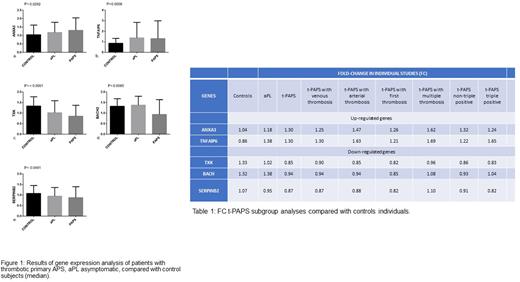Abstract
Introduction: Whether different manifestations of thrombotic antiphospholipid syndrome (APS) share pathological mechanisms has not been established. Transcriptome analysis may constitute a new approach to evaluate the mechanisms behind thrombotic manifestations in APS.
Aim: To determine in patients with primary thrombotic APS (t-PAPS) and aPL asymptomatic (individuals carrying the antibodies but without clinical manifestation) the expression of genes already related to venous and arterial thrombosis in general population compared with control.
Method: mRNA was obtained from total leucocyte and gene expression was measured by qPCR and the results were analyzed by QuantStudio™ Software.
Results: 100 t-PAPS, 17 asymptomatic aPL carriers and 100 control individuals were included. The group of t-PAPS were 63.73% female, and the median age was 40 years (IQR 31-53). Asymptomatic aPL carriers were mostly female (82.36%) and the median age was 36 years (IQR 24-59). Controls were mostly female (67%) and their median was 39 years (IQR 29-49). No significant demographic differences between the groups was observed. Cardiovascular risk factors were more prevalent among t-PAPS than among asymptomatic aPL carriers and controls (37.25%, 5.88% and 9% respectively).
ANXA3 (P=0.0292) and TNFAIP6 (P=0.0006) mRNA were up-regulated while TXK (P=< 0.0001), BACH2 (P=0.0085) and SERPINB2 (P=0.0491) were down-regulated in t-PAPS when compared to controls. In aPL carriers, the relative expression levels of TNFAIP6 were similar to t-PAPS while that of BACH was similar to controls; as shown in Figure 1.
In a subgroup analysis, ANXA3 and TNFAIP6 mRNA expression was more pronounced in t-PAPS with multiple thrombosis (P= 0.0027 and P=< 0.0001 respectively), while TXK mRNA expression was lower in all t-PAPS subgroups in comparison with controls, being particularly lower in patients who had first thrombotic event and non-triple positivity (P=< 0.0001 and P= < 0.0001 respectively), BACH2 mRNA expression was lower in t-PAPS subgroup with first thrombotic event (P= 0.0019) compared to the control group and SERPINB2 mRNA expression was only significantly lower in t-PAPS with first thrombotic event (P= 0.0071). Table 1 demonstrates fold changes by different manifestations of t-PAPS.
Discussion: We observed a dysregulation of genes related to hemostasis (ANXA3 and SERPINB2) and inflammation (TNFAIP6, TXK and BACH2) in t-PAPS, when compared to controls. ANXA3 plays a role in cell growth regulation and signal transduction pathways, and has previously been linked to stroke in animal studies. TNFAIP6 is involved in cell-cell and cell-matrix interactions during inflammation and tumorigenesis. Among TXK related pathways are the transmigration of immune cells and plays a role in regulating the adaptive immune response. BACH2 is responsible for immune regulation, mainly related to the adaptive immune response and has been implicated in B cell. SERPINB2 regulates the production of the plasminogen activator inhibitor-2 (PAI-2), being directly related to the hemostasis pathways. Such mechanisms were not evident among asymptomatic aPL carriers. In subgroup analysis, the relative expression of genes related to innate immunity has also been associated with signs of disease severity, such as multiple thrombosis and triple positivity.
Conclusions: Our results showed that innate immunity and hemostasis pathways are associated with t-PAPS at a transcriptome level and innate immunity may play a role in disease severity.
Acknowledgements: São Paulo Research Foundation FAPESP (2019/20136-0)
Disclosures
No relevant conflicts of interest to declare.
Author notes
Asterisk with author names denotes non-ASH members.


